A global forest tour for World Wildlife Day
From the Congo to Germany to Indonesia, three Max Planck scientists guide you deep into the forests where they conduct research
Cuvette Centrale, Democratic Republic of the Congo
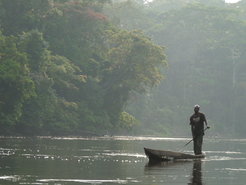
Group Leader Barbara Fruth works in the Congolese rainforest, the second largest in the world, where she studies endemic wild bonobos. With PhD student Mattia Bessone, the pair are currently working on a conservation project that seeks to improve methods for estimating bonobo distribution and abundance in the wild. Here, Mattia recounts what the pair have learnt about the world’s second-largest rainforest.
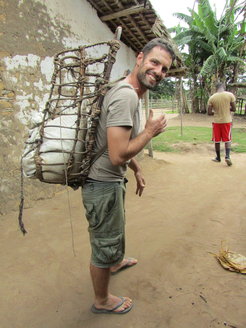
Barbara and I conduct field work in the Democratic Republic of the Congo. More precisely, we work south of the Congo river, in a 500,000km2 area of lowland rainforest called the Cuvette Centrale. At the very heart of the Cuvette lies Salonga National Park, a huge protected area the size of Belgium.
One of the projects we have been working on in Salonga has been a biodiversity inventory, led by Barbara, investigating mammal diversity and abundance. Using camera traps, we have identified 43 species in the area, including some secretive and understudied species such as Congo peafowl, the giant ground pangolin and the cusimanses (see image below).
Many frugivorous species—but in particular forest elephants and bonobos—are essential to the functioning, maintenance, and regeneration of the rainforest. In the Congolese rainforest, there are tree species such as Autranella congolensis with seeds protected by hard casings. Usually, these seeds stand much higher chances of germinating if first softened by the elephant’s gastric liquids. However, elephant numbers have shrunk dramatically in the wild across the past century. By losing its main disperser, Autranella congolensis is considered critically endangered.
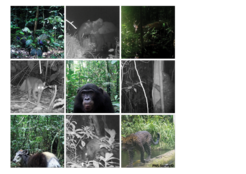
Row 1: Congo peafowl, forest elephant, sitatunga;
Row 2: African golden cat, bonobo, giant ground pangolin;
Row 3: yellow-backed duiker, aardvark, leopard.
Another fundamental service provided by elephants is their role as forest architects. With their size, they often fell trees by moving across the forest’s thick vegetation, creating clearings. By that, light is allowed to reach the ground, providing the conditions for the dormant seeds to germinate and thrive. This new vegetation is an important source of food for other browsers in the forest including elephants. As a result, elephants may keep these clearings open, creating what is called an “elephant bai,” which are real biodiversity hotspots.
Preserving a healthy and diverse animal community is essential because of the subtle inter-dependence among very different species. An example I particularly like comes from our camera trap study. We noticed a very strong correlation between the number of bonobo videos and number of duiker videos. It was puzzling, because even though we would expect a healthy forest area to have lots of bonobos and duikers, the relationship was so strong as to raise suspicion. The answer was simple. Forest duikers follow bonobos and monkeys to feed on the fruits dropped by the arboreal primates. There must be hundreds of examples like this out there!
Radolfzell, Germany
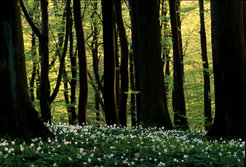
As possibly the only MPI-AB scientist born in Radolfzell, Group Leader Wolfgang Fielder knows a thing or two about the local forests and the threats that forest dwelling birds face. Together with Gunther Bauer, he contributes to the Red List for birds in Germany, which is due to be published in March this year. Here, Wolfgang reports on the status of local forest bird populations and gives insight into what makes local forests habitats so special.

Forest habitats, apart from wetlands, are the only truly natural habitats in our region. Before man began to cultivate fields and pastures 2000 years ago, large parts of Central Europe consisted of vast forests. Animals, plants and fungi in the forest thus form the oldest biotic communities that we can find in our area. Unfortunately, only a few truly natural forest habitats remain. Modern forestry is responsible for the fact that our forests no longer reach their natural age of 300 to over 500 years, but are harvested after only 100 years. Species that are specialised in old forests are therefore severely threatened.
The other threat to local forests is that summers are now extremely dry. If you visit the Schaffhausen area you can see many dead trees after just three dry years. Funnily enough, this has been a short-term boon for birds because trees are producing abundant fruit as a stress response. This means that for several years there has been lots of food for forest birds. But of course the fact that forests are drying out is a worrying trend for the longer term.
Sumatra, Indonesia
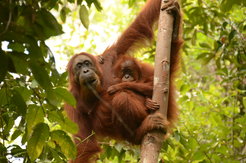
For the last 10 years, Caroline Schuppli has been traveling to Sumatra, Indonesia, where she studies a population of 15 immature orangutans and their mothers. Among other topics she investigates how immature orangutans learn and which factors affect the development of cognitive performance as well as the size and complexity of their skill repertoires. Here, she describes the Suaq forest, how it has changed over a decade, and how orangutans can cope with change.
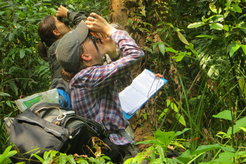
The Suaq Balimbing forest is a beautiful primary forest. It’s a highly productive forest which means that there are fruit bearing trees all year round. Because of this high productivity, the Suaq forest has a very high species richness and density. Walking through the Suaq forest feels a bit like walking though the jungle as you imagined it as a child: it is full of animals and incredibly noisy. Suaq is home to the densest population of Sumatran orangutans and six other primate species including siamangs, white handed gibbons and slow loris. Our research area is also the core home range of a Sumatran tiger female. For observers, this beauty comes at a cost: the Suaq forest is also deep peat swamp which means that moving around is very difficult and wet.
Luckily, the forest inside the research area has not changed a lot. However, the surrounding areas have been heavily affected by logging. Suaq used to be in the middle of a huge patch of forest and now it is at the edge of a shrinking patch of forest. Through our work with the local communities over the last 5 years, we could effectively reduce the logging in the immediate surroundings of the research area. However, the logging is still ongoing in the further away areas. This affects the forest and the local communities alike: we nowadays get more and heavier flooding every year and the orangutans in these areas have started crop raiding.
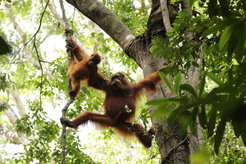
Orangutans depend on socially transmitted knowledge and skills, which means that they are highly cultural. Infant orangutans will spend 10 years from its mother before they are competent enough to spend time on their own. They will then continue to learn from peers and other adult individuals for another 5 years before they start reproducing. This socially transmitted knowledge accumulates over generations. For conservation it is important to keep in mind that orangutans are highly cultural – they need to learn about their intact habitat from other individuals to be able to survive in it. With every population of orangutans we lose, we do not just lose individuals, but entire cultures.







